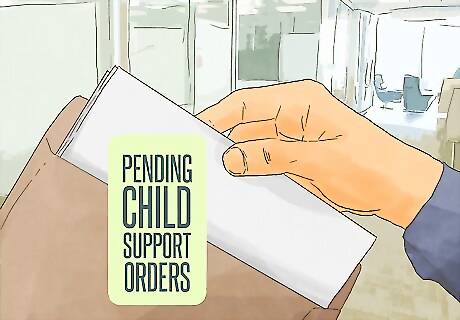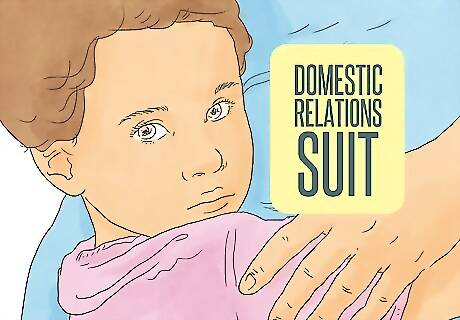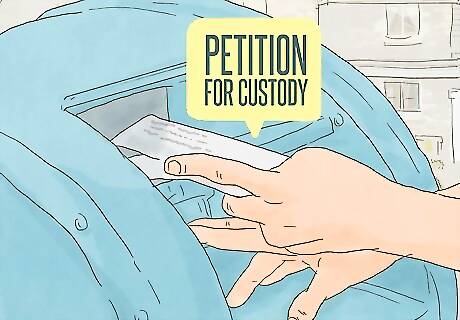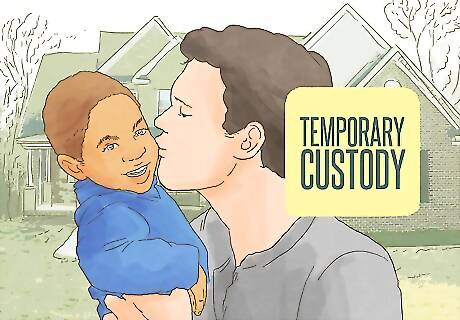
views
Filing for Custody in Divorce or Separation

Work on a parenting plan. Child custody is a major question in a divorce where the couple has children. If both spouses can agree to a parenting plan, the court will not have to hold a trial or hearing to determine custody. Talk to the other parent about how to divide the child's time at both of your homes. Remember to account for each parent's work schedule and the child's school schedule. For example, if you sometimes work an evening shift and will not be home to care for the child, let the other parent have the child on those days. Decide who will get physical custody. The child lives primarily with the parent who has physical custody. The other parent has visitation rights, and can visit the child or have the child visit him or her. Decide who will get legal custody. Legal custody refers to the right to make decisions about the child's health care, education, and religious upbringing. It is possible for one parent to have physical custody, while they both share joint legal custody.

Talk to a mediator. If you have any trouble reaching agreement, try talking with a third party who can act as a neutral negotiator to help you make the best decisions. Every county in Oregon has a court-connected mediator program, which can help parents construct a parenting plan. Depending on the county, these services may be offered free of charge. Ask the court clerk how you can schedule mediation with a court-connected mediator. Some counties require that parents of minor children attend mediation during divorce proceedings.

Consider any safety concerns. Oregon provides sample parenting plans to use as starting points for creating a parenting plan of your own. Some sample plans are intended for use in situations where there are concerns about the child's safety. Safety-focused plans can specify that one parent can only have supervised visitation with the child, or place limits on overnight visitation. Consider a safety-focused plan if the other parent has ever: Hurt you, the child, or a pet when angry; Threatened or attempted suicide; Abused alcohol or drugs; Kept your child from you; Threatened anyone; Sexually abused anyone; or Needed medication to be safe around others.

Fill out a "Parenting Plan" form. You can find blank Parenting Plan forms at http://www.courts.oregon.gov/forms/Documents/BasicParentingPlanForm.pdf. Use this form to write down the parenting agreement between you and the other parent. The form is very detailed, prompting you to enter holiday and vacation schedules, and also has space to arrange for other special events or occasions. You can find sample plans with instructions at http://www.courts.oregon.gov/programs/family/children/Pages/parenting-plans.aspx. There are different samples for families with children of different ages. You can also find sample safety-focused plans at http://www.courts.oregon.gov/programs/family/children/Documents/SafetyFocusedParentingPlanGuide.pdf. Follow the instructions included with your forms, type or print neatly in blue or black ink, and fill in each numbered item as necessary. If you are unable to agree on what the details of the custody and visitation form should be, consult a mediator. If you still cannot reach an agreement, you will have to ask the judge to resolve the dispute at a trial or hearing. The judge will try to make a decision that is in the best interests of the child.

Have your forms reviewed. Before anything is signed, have your forms reviewed by a courthouse facilitator. Most courts in Oregon have a courthouse facilitator program, which helps people with family law cases. Most facilitators offer document review services, either for walk-ins or by appointment. You can find detailed information for facilitator services in each county at http://www.courts.oregon.gov/programs/family/Documents/FacilitatorsList.pdf. Facilitators do not represent you or give legal advice, but they can review your forms and help you with any questions you have about the process.

File the forms with your local court. Make copies of your forms and take them to the court clerk. The clerk will stamp the original and the copies as "filed" and retain the original document. The judge will review the agreement and sign the bottom of the form. Once the form is signed by the judge, the agreement becomes a court order, and both parents are required to follow the agreement. Your parenting plan should be part of your divorce/dissolution petition. The filing fee for a dissolution of marriage is $273.00. If you cannot afford to pay the filing fee, ask the court clerk for information about filing an application for a fee waiver.
Filing for Custody When the Parents are Unmarried

Determine whether you are the legally recognized father of the child. To have full custody and visitation rights, the father of the child must be legally recognized as the child's parent. If a man is married to a child's mother when the child is born, the man is presumed to be the child's father. The other ways to establish paternity are a Voluntary Acknowledgment of Paternity or a court order. Acknowledgment of Paternity forms are given to the mother in the hospital at the time the baby is born and must be signed before a hospital witness. To get a court order establishing paternity, contact the Oregon Child Support Services Program and ask how you can file an Application for Support Enforcement Services. You can contact the Oregon Child Support Services Program office by calling one of the phone numbers listed at https://www.doj.state.or.us/child-support/locations/.

Complete a "Petition for Custody and Parenting Time" form. This form is available at http://www.courts.oregon.gov/forms/Documents/UnMarr%20Petition.pdf. The form is used to request a parenting plan and child support obligation from the court. You will need to state how you are the child's legally recognized father. Once you complete this form and have it reviewed, mail it to Division of Child Support, 5193 NE Elam Young Parkway, Suite B, Hillsboro, OR 97124.

Fill out a "Summons- Domestic Relations Unit" form. This form is available at http://courts.oregon.gov/OJD/docs/OSCA/cpsd/courtimprovement/familylaw/Summons-3AB-Ver04.pdf. It is used to give notice to the other parent that you have initiated a case to establish a parenting plan. The form gives the other parent instructions for how to respond to your petition.

Attach a "Certificate Regarding Pending Child Support Proceedings and/or Existing Child Support Orders/Judgments" form. Use this form to describe the details of any existing child support orders, or verify that there are no such orders in place.

Fill out a "Family Law Confidential Information" form. You can find this form at http://www.courts.oregon.gov/Washington/docs/familylaw/2016%20-%20Updated%20Documents/Unmarried%20Parents%20Custody/5Confidential_Information_Form.pdf. Use this form to enter detailed identifying information about the parties and children. This information is not generally accessible to the public, and will be kept confidential. You must also complete a "Notice of Filing of Confidential Information Form."

Complete a "Summons- Domestic Relations Suit" form. This form is available at http://www.courts.oregon.gov/Washington/docs/familylaw/2016%20-%20Updated%20Documents/Unmarried%20Parents%20Custody/9Summons.pdf. It is used to give notice to the other parent that you have initiated a case to establish a parenting relationship with the child. The form gives the other parent instructions for how to respond to your petition. Attach a "Notice of Statutory Restraining Order Preventing Changes to Insurances in Domestic Relations Actions." This form is available at http://www.courts.oregon.gov/Washington/docs/familylaw/2016%20-%20Updated%20Documents/Unmarried%20Parents%20Custody/8Notice_of_Statutory_Restraining_Order.pdf. This document informs both parents that they are not allowed to cancel or change health or life insurance policies that cover the child or the parents.

Complete a "Petitioner's Certificate of Mail to the Division of Child Support" form. This form is available at http://www.courts.oregon.gov/Washington/docs/familylaw/2016%20-%20Updated%20Documents/Unmarried%20Parents%20Custody/12Certificate_of_Mailing.pdf. By signing this form, sign this form after you mail a copy of the "Petition for Custody" to the Division of Child Support, 5193 NE Elam Young Parkway, Suite B, Hillsboro, OR 97124.

Have your forms reviewed. Before anything is signed, have your forms reviewed by a courthouse facilitator. Most courts in Oregon have a courthouse facilitator program, which helps people with family law cases. Most facilitators offer document review services, either for walk-ins or by appointment. You can find detailed information for facilitator services in each county at http://www.courts.oregon.gov/programs/family/Documents/FacilitatorsList.pdf. Facilitators do not represent you or give legal advice, but they can review your forms and help you with any questions you have about the process.

File the forms with your local court. Make copies of your forms and take them to the court clerk. The clerk will stamp the original and the copies as "filed" and retain the original document. Filing your forms initiates a court case. The clerk will contact you to give you a hearing date. The filing fee is $252.00. If you cannot afford to pay the filing fee, ask the court clerk for information about filing an application for a fee waiver.

Serve the other parent. You will need to have copies of your forms delivered by the sheriff, a professional process server, or someone over 18 and not involved in the case. Have that person complete and sign a "Declaration of Service" form, which is available at http://courts.oregon.gov/Washington/docs/familylaw/3a_unmarried_petition/affidavitofservice-3a.pdf, and file the form with the court. If you cannot locate the other parent to serve him or her, check with friends, family, employers, former landlords, the tax collector's records, the DMV, and the post office. You can even hire a private investigator. If all else fails, ask the court clerk how to request permission from the court to give "constructive notice" by publishing notice of the case in the newspaper.

Attend the hearing. At the hearing, the judge will ask you to answer any questions he or she has about the request you have submitted. The other parent will have the opportunity to state why he or she might object to you having custody. Try to anticipate these arguments and figure out in advance how you want to respond.
Filing for Custody in a Paternity Case

Complete an "Application for Child Support Services" form. This form is available at https://www.doj.state.or.us/child-support/resources/forms/. You will need to provide information about yourself and about the other parent. Check the boxes indicating that a court has not yet established paternity for the child.

Attach an "Affidavit in Support of Establishing Paternity" form. This form is available at https://www.doj.state.or.us/wp-content/uploads/2017/06/csf110112.pdf. Use the form to provide details about your relationship with the other parent, including specifics of when the child was conceived. Do not sign the affidavit before you have it notarized.

Have your affidavit notarized. Sign the affidavit in the presence of a notary public. The notary will notarize your paperwork, verifying that you signed the document in his or her presence. Bring a valid form of identification, such as a driver's license or passport, to verify your identity. To find a notary online, visit the Notary Public Directory. You can also find a notary public by visiting your local bank. Most banks do not charge a fee for notary services if you are a bank customer. If you are not a bank customer, you can use the bank's notary service for a small fee.

Submit your forms. Mail your forms to CSP, 4600 25th Ave NE, Suite 180, Salem, Oregon 97301. Alternatively, you can take it to your local child support office. You can find the locations and phone numbers of the child support offices in Oregon at https://www.doj.state.or.us/child-support/. You will be charged a $1.00 fee for this service.

Wait for a response. The child support office will process your case for you, and will contact you if they need you to provide additional information. The Department of Child Support or District Attorney's office will serve you and the other parent with copies of papers after the case has been initiated. Thus, you will be notified when a hearing is scheduled.

Attend the hearing. At the hearing, the judge will ask you to answer any questions he or she has about the request you have submitted. The other parent will have the opportunity to present evidence to try to prove that you are not the child's father. Once your paternity is established, you can request custody and a parenting plan.
Filing for Temporary Child Custody in an Emergency

Fill out an "Ex Parte Motion for Temporary Custody and Parenting Time" form. This form is available at http://courts.oregon.gov/OJD/docs/osca/cpsd/courtimprovement/familylaw/motion-16aver02.pdf. You can use this form to get temporary custody quickly when, due to danger to the child or other emergency circumstances, you cannot wait to get a permanent custody order. You must have already filed for divorce, separation, or custody before (or at the same time) you file this motion. Use the space provided to explain to the court why you are requesting an emergency custody order. The other parent will get some notice of your emergency motion, but he or she is not required to be there for the judge to make a decision. If you already have a custody judgment resulting from a divorce, separation, or custody case, fill out an "Ex Parte Motion for Post-Judgment Temporary Custody and Parenting Time" instead. You can find the form at http://courts.oregon.gov/OJD/docs/osca/cpsd/courtimprovement/familylaw/motion-16bver02.pdf. You will need to demonstrate to the court that the child is in immediate danger and that the child should be placed in your custody for the child's safety.

Complete an "Affidavit in Support of Ex Parte Motion for Temporary Custody and Parenting Time" form. This form is available at http://courts.oregon.gov/OJD/docs/osca/cpsd/courtimprovement/familylaw/affidavit-16aver02.pdf. Use this form to provide additional information about your situation, including how you know that your child is in immediate danger. Sign your affidavit before a notary public or the court clerk, who can also sign and verify that you signed the form yourself. If you already have a custody judgment resulting from a divorce, separation, or custody case, fill out an "Affidavit in Support of Motion for Post-Judgment Temporary Custody and Parenting Time " instead. You can find the form at http://courts.oregon.gov/OJD/docs/osca/cpsd/courtimprovement/familylaw/affidavit-16bver02.pdf.

Include an "Ex Parte Order for Temporary Custody and Parenting Time" form. This form is available at http://courts.oregon.gov/OJD/docs/osca/cpsd/courtimprovement/familylaw/order-16aver02_001.pdf. You can leave this form blank. The judge will fill out the court's orders, including whether you shall have custody of the child, for how long, and whether the other party is restrained from having contact with the child. If you already have a custody judgment resulting from a divorce, separation, or custody case, fill out an "Ex Parte Order for Post-Judgment Temporary Custody and Parenting Time" form. instead. You can find the form at http://courts.oregon.gov/OJD/docs/osca/cpsd/courtimprovement/familylaw/order-16bver04.pdf

Have your forms reviewed. Before anything is signed, have your forms reviewed by a courthouse facilitator. Most courts in Oregon have a courthouse facilitator program, which helps people with family law cases. Most facilitators offer document review services, either for walk-ins or by appointment. You can find detailed information for facilitator services in each county at http://www.courts.oregon.gov/programs/family/Documents/FacilitatorsList.pdf. Facilitators do not represent you or give legal advice, but they can review your forms and help you with any questions you have about the process.

File the forms with your local court. Make copies of your forms and take them to the court clerk. The clerk will stamp the original and the copies as "filed" and retain the original document. Filing your forms initiates a court case. The clerk will contact you to give you a hearing date. There is no filing fee.

Attend the hearing. When you return to court for the hearing, the judge will ask you questions about your petition before he or she grants your request. The child's other parent will have the opportunity to deny any allegations of abuse or neglect. Bring any evidence and witnesses you can use to demonstrate that it would be in the child's best interests to be removed from the parent and placed in your care.

Serve the other parent. Have the affidavit, motion, and signed order from the judge served on the other parent. You cannot serve the other parent yourself, but you can have the sheriff's office, a professional process server, or someone who is over 18 and not part of the case serve him or her for you. If you cannot locate the other parent to serve him or her, check with friends, family, employers, former landlords, the tax collector's records, the DMV, and the post office. You can even hire a private investigator. If all else fails, ask the court clerk how to request permission from the court to give "constructive notice" by publishing notice of the case in the newspaper.

File an "Affidavit of Service" form. Have the person who served the other parent complete an Affidavit of Service, which is available at http://courts.oregon.gov/OJD/docs/osca/cpsd/courtimprovement/familylaw/affidavitsrv16aver02_000.pdf. By signing this form, he or she verifies that the other parent was served. Then you must file the affidavit with the court clerk. If you already have a custody judgment resulting from a divorce, separation, or custody case, fill out this form instead: http://courts.oregon.gov/OJD/docs/osca/cpsd/courtimprovement/familylaw/affidavitsrv16bver02_000.pdf.




















Comments
0 comment